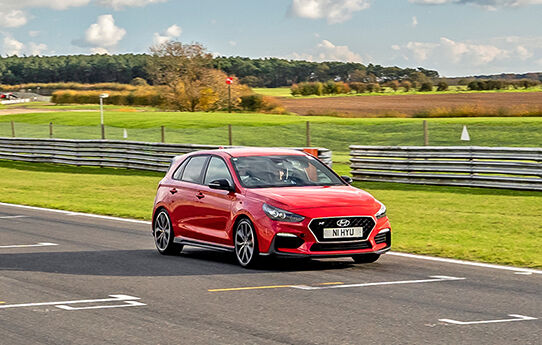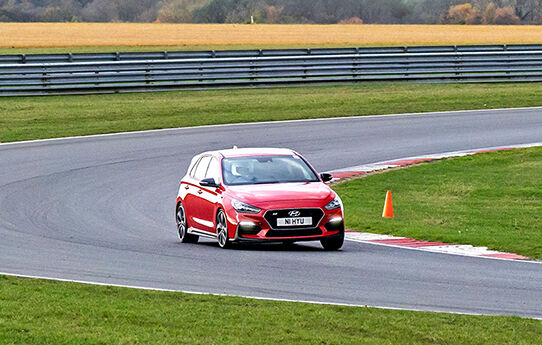09 April 2020
High-performance cars are vehicles that are above average in performance in one or more of the following abilities such as: speed, acceleration, braking, and cornering. You might have experience getting confused with the terms used to describe the parts and technologies of a high-performance car.
The terms used for parts like the spoiler, splitter, and diffuser, and systems like ECS, eLSD, ESC, rev-matching, active exhaust, and launch control may sound complicated and intimidating at first, but we’re here to explain some common high-performance car terms so you can fully understand their exciting features.
Table of Contents
Table of Contents Here
- 1. Parts
- Spoiler
- Splitter
- Diffuser
- 2. Systems
- ECS
- eLSD
- Rev-Matching
- Active Exhaust
- Launch Control
- ESC
Spoiler
A spoiler is designed to ‘spoil’ the unfavorable air movement, commonly described as turbulence or drag, across the body of a car to prevent the vehicle from being lifted. It helps to increase driving performance by converting the air flowing from front to back into downward pressure when driving at high speed. Moreover, the spoiler controls the airflow so that the vortex of air from behind the car does not create a drag force that pulls the running vehicle back.
Spoilers can be mounted both on the front and rear of the car, but usually, the spoiler is located at the rear of the body, because the front spoiler is in fact a splitter.

Splitter
When a car is driven at a high speed, air collides with the front of the car causing the air pressure to build up, and this high-pressure air usually flows underneath the car. The narrow space of the car underbody speeds up the airflow which then leads to the lift and reduced traction on the road, causing the instability of the vehicle.
This is when the splitter, typically attached to the bottom of the front bumper, contributes to the car's performance by splitting the air flowing under the vehicle and reducing the lift. The splitter splits the air and directs part of it upward, reducing the amount of air flowing downwards, creating a downforce effect. This prevents the front of the vehicle from floating upwards, helping to create grip and driving safety when driving at high speeds.

Diffuser
The diffuser is another aerodynamic part that plays a complementary role in the opposite position of the spitter. While a splitter is a device that reduces air entering the car underbody, a diffuser is a part that allows air that has already flowed under the car to make its way out again.
By shaping the rear of the car underbody upward, the diffuser allows the air flowing into the car underbody to flow through a wide passage. This reduces the air velocity and increases the pressure of the high-speed and low-pressure air, flowed underneath the car, and let it naturally flow back out to the atmosphere. As a result, the diffuser increases stability by controlling the turbulence generated behind the vehicle and generates the downforce. Also, it reduces the drag force by minimizing the vacuum area behind the vehicle body, helping to improve fuel efficiency.

Electronic Controlled Suspension (ECS)
An ECS system ensures a smooth drive and better handling even in challenging driving conditions. The computer-controlled system improves performance and adapts to road conditions by adjusting the car’s suspension and modifying the shocks and struts.
For example, the Hyundai i30 N sports an ECS with four variable dampers that are mounted on the independent four wheels. With its lower and firmer suspension and the electronically controlled dampers, the car automatically adjusts its damping force based on speed, driver input, and road condition. This enables superior handling and body control despite harsh driving conditions on the racetrack.

Electronic Limited-slip Differential (eLSD)
A limited-slip differential (LSD) assures that each wheel receives sufficient torque to prevent slippage. In contrast to a limited-slip differential, an open differential does not control the amount of torque each wheel receives. Thus, in case one wheel doesn’t have enough traction, all the torque is transferred to the wheel with no traction, while the other wheels receive almost no torque which can lead to slippage or the car not being able to drive.
An electronic limited-slip differential (eLSD) uses an electronic control unit to monitor input from wheel sensors to accurately identify when a certain wheel needs extra torque to enhance grip. Hence, an eLSD improves handling during cornering and high-speed driving on the racetrack, as well as during difficult driving conditions such as ice and snow. Generally, an eLSD has the same purpose as a regular LSD but provides higher speed and accuracy. The speed and accuracy of an eLSD are especially important on the racetrack where milliseconds decide wins and losses.
As an example, the i30 Fastback N’s N Corner carving differential is an eLSD that enhances the grip of the wheels to deliver maximum power on the road while increasing the maximum cornering speed.

Rev-matching
Rev-matching is used when down-shifting with manual transmission vehicles to ensure a smooth transition between gears. If you’ve driven a manual transmission car before, you might have noticed the unpleasant experience of the car revolting and bucking when you downshift while the engine is spinning at a high RPM. To prevent this, the automatic rev-matching function of many high-performance cars automatically blips the throttle when downshifting, matching the speed of the engine to the optimal gear speed and thus stabilizing the car while braking.
With the Hyundai i30 N’s automatic rev-matching feature that can be turned on with a button on the steering wheel, the performance car provides advanced cornering abilities. Enjoy smooth and fast downshifting before a corner and get maximum speed when exiting that corner.

Active Exhaust
An active exhaust system allows drivers to change the loudness of the car’s exhaust system to bring the performance car experience to a new level. With full sound, you can live out your race car dreams, and for your everyday commute, you can go with a more contained exhaust sound.
The Veloster N comes with a high-flow active sport exhaust with three distinctive settings and a variable actuator to provide a marvelous sound experience while driving, just like a full-throttle race car.

Active Exhaust
An active exhaust system allows drivers to change the loudness of the car’s exhaust system to bring the performance car experience to a new level. With full sound, you can live out your race car dreams, and for your everyday commute, you can go with a more contained exhaust sound.
The Veloster N comes with a high-flow active sport exhaust with three distinctive settings and a variable actuator to provide a marvelous sound experience while driving, just like a full-throttle race car.


Launch Control
A launch control system ensures maximum traction to facilitate the fastest possible start regardless of weather or road conditions. The system controls engine torque to optimize wheel spin and slip while accelerating for a quick launch.
As this exciting feature helps to increase the performance in a race, many performance cars have integrated this feature, and so do Hyundai N performance cars such as the i30 N, the Veloster N, and the i30 Fastback N. The Hyundai N cars’ launch control system provides a combination of an accelerator and electronic optimization to provide maximum power delivery to wheels and gearbox.
Launch Control
A launch control system ensures maximum traction to facilitate the fastest possible start regardless of weather or road conditions. The system controls engine torque to optimize wheel spin and slip while accelerating for a quick launch.
As this exciting feature helps to increase the performance in a race, many performance cars have integrated this feature, and so do Hyundai N performance cars such as the i30 N, the Veloster N, and the i30 Fastback N. The Hyundai N cars’ launch control system provides a combination of an accelerator and electronic optimization to provide maximum power delivery to wheels and gearbox.

Electronic Stability Control (ESC)
The electronic stability control (ESC) system is an important safety feature that improves a car’s stability. The computerized technology detects when the driver loses control over the car and when the car loses traction and improves the car’s stability by applying individual brakes to keep the car on track. Depending on the ESC system, the car’s engine power might decrease until the car obtains stability and control.
Due to the harsh driving conditions on the racetrack, performance cars require ESC systems that provide additional safety but don’t disturb the driver’s racing experience.
This is why the N traction and stability control is an ESC system that Hyundai developed to help the driver whenever necessary, while not disturbing the driver and allowing for maximum speed and driving fun on the track. For a limitless racetrack experience, the N traction and stability control can be completely turned off.

Performance Car Terminology
While there are many more exciting high-performance car features, the aerodynamic parts and systems introduced in this post are powerful features that deliver an excellent and action-packed racing experience.
Even if these terms might sound unfamiliar and intimidating at first, once you understand the basic function and purpose of these car features, you’ll be able to use them freely when talking about your favorite performance cars.
Meet the N performance parts to enhance the performance and uniqueness of your car





